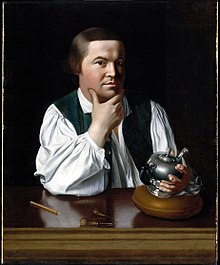
Atsidi Sani
United States
Date of Birth: 1830 — 1918
Sani played an important role in the history of Navajo silversmithing. He is known by many to be the first Navajo silversmith, although his main focus was in blacksmithing; working with iron. Many agree that he learned silversmithing in the year 1853. According to Navajo tribal leader, Chee...

Tommy Singer
United States
Date of Birth: 1940 — 2014
Tommy Singer (born 1940; death May 31, 2014) was a Navajo silversmith who specialized in chip-inlay jewelry. He died in a motorcycle accident on May 31, 2014. His inlaid turquoise, coral, and silver pieces incorporated traditional Navajo designs. Singer gained acclaim as the originator of the chip...

Paul de Lamerie
United Kingdom
Date of Birth: 1688 — 1751
Paul de Lamerie (9 April 1688 – 1 August 1751) was a London-based silversmith. The Victoria and Albert Museum describes him as the "greatest silversmith working in England in the 18th century". Though his mark raises the market value of silver, his output was large and not all his pieces are...

David Austin Sayre
United States
Date of Birth: 1793 — 1870
David Austin Sayre (March 12, 1793 - September, 1870) was a prominent silversmith, banker and educator. Sayre is best remembered as founder of Sayre Female Institute.

George Guess, aka Sequoyah
United States
Date of Birth: 1767 — 1843
Sequoyah (Ssiquoya, as he signed his name, or Se-quo-ya, as is often spelled in Cherokee; named in English George Gist or George Guess) (c.1770-1843), was an American and Cherokee polymath. In 1821 he completed his independent creation of a Cherokee syllabary, making reading and writing in...

Mario Buccellati
Italy
Date of Birth: 1891 — 1965
Founded in 1919 when Mario Buccellati took over Milan's Beltrami & Beltrami, Buccellati is known for its richly textured pieces that are influenced by Renaissance motifs and nature. He was the first famous for the technique of texture-engraving where pieces look like silk, damask, tulle, lace,...

Jean Baptiste Claude Odiot
House of Odiot
France
Date of Birth: 1763 — 1850
The House of Odiot was founded in 1690 by Jean-Baptiste Gaspard Odiot but rose to prominence under Jean-Baptiste Claude, Gaspard's grandson. Jean-Baptiste Claude was influenced by classical Greek and Egyptian motifs as expressed in the Directoire and Empire styles.
Odiot purchased many of Henry...

Jean Puiforcat
France
Date of Birth: 1897 — 1945
Founded in Paris in 1820 by Louis-Victor and Emile Puiforcat and their cousin, Puiforcat rose to fame as one of the great French silversmiths. The Puiforcat collection features outstanding designs ranging from classical through Art Deco to modern design. Many of the works were recreated from...

Paul Storr
HUNT & ROSKELL
United Kingdom
A manufacturing firm, retail jewellers and silversmiths founded by Paul Storr in 1819 as Storr & Co. John Samuel Hunt, who had assisted Storr from the start, continued as a partner until his death in 1865 when he was succeeded by his son, John Hunt. Robert Roskell joined in 1844 and remained in...

Jonathan Mappin
Mappin & Webb
United Kingdom
Date of Birth: 1775
In 1775, teenager Jonathan Mappin started a small cutlery workshop in Sheffield. Within a year the first Mappin hallmark was recorded at the assay office. But it was under his four great-grandsons who incorporated the business as Mappin Brothers Ltd in the middle of the 19th century. In 1963...

Robert Hennel, & Sons
United Kingdom
Date of Birth: 1800
Hennell of Bond Street is one of London's oldest silversmiths and jewellers. It was founded by David Hennell and originally made fashionable silverware for the nobility and landed gentry. David's son, Robert I, is known for his fine neoclassical silver, often with bright-cut engraving. His son,...

George Wickes
Garrard & Co.
United Kingdom
Date of Birth: 1735
Originally founded in 1735 by royal silversmith George Wickes, the firm was eventually taken over by Robert Garrard in partnership with John Wakelin in 1792. Garrard had many aristocratic patrons and was represented at numerous international exhibitions including the Great Exhibition of 1851....

George & Henry Richards
Elkington Kingston & Co.
United Kingdom
Date of Birth: 1830
Brothers George Richards and Henry started G. R. Elkington & Co in the 1830s. The firm then operated independently as Elkington & Co. for over 100 years. In 1840 Elkington & Co. patented the electrolytic process for silver plating that is still in use today and they expanded at an incredible...

William Chawner
United Kingdom
Date of Birth: 1797 — 1834
Flatware-making is one of the sub-specialties of silversmithing. In the 18th and 19th centuries, the vast majority of spoons and forks were made by specialist 'spoon makers' (knives were made by an entirely different tradesman called a cutler). The Chawner family was one of England's dominant...

Hester Bateman
United Kingdom
Date of Birth: 1708 — 1794
The most famous woman silversmith, Bateman was the widow of John Bateman. After his death in 1760, she took over his London-based metalwork business and transformed it into one of the most successful and prolific silversmithing workshops in London. Hester and her sons were known for their...

George Adams
United Kingdom
Date of Birth: 1840 — 1883
William Chawner II's son-in-law who took over Chawner & Co. with his mother-in-law Mary Chawner. He took over the firm and registered his first mark in 1840. He was an exhibitor at the 1851 Great Exhibition and the company became one of the largest producers of quality silver flatware in...

Charles Tiffany
Tiffany & Co.
United States
Date of Birth: 1837
America's most famous silversmith from the mid 19th to early 20th century. The company began in 1837 when Charles Lewis Tiffany and John Young opened Tiffany & Young. In 1851, Tiffany became the first American firm to introduce the .925 English Sterling Standard in American-made silver. The name...

Carl Poul Peterson
Canada
Date of Birth: 1895 — 1977
According to his family history, Carl Poul Petersen apprenticed at Georg Jensen in Denmark before emigrating to Canada in 1929. He worked at Henry Birks and Sons in Montreal but he also set up a studio for commission work in the late thirties. Petersen left Birks and opened his permanent studio...

Jabez Gorham
Gorham Manufacturing Company
United States
Date of Birth: 1831
Established in 1831 in Rhode Island, as a coin-silver flatware and jewelery manufacturer, Gorham eventually became one of the largest silversmiths in the world. By the late 1860s, they grossed $1 million in sales per year. Gorham was tremendously successful with flatware patterns like Chantilly,...

Henry Birk, & Sons
Canada
Date of Birth: 1879
Birks was by far the largest and most influential Canadian silversmith in the 20th century. Henry Birks & Company was established in Montreal in 1879 as a retail jeweler. It became Henry Birks & Sons in 1893 when his three sons joined the business. In 1897 Birks bought out Hendery & Leslie,...

Charles Christofle
France
Date of Birth: 1805 — 1863
Charles Christofle founded the company that bears his name in 1830. Originally a jeweler, he bought the patents silver plating and electrolytic gilding of gold in 1842. As a goldsmith, he transformed ceremonial items and everyday objects: from jewelry to cutlery, gold smithery to sculptures, and...

Jean Puiforcat
France
Date of Birth: 1897 — 1945
Jean Puiforcat served in WW1. After the war, he apprenticed as a silversmith and a designer. He lived in Paris. He designed in the art deco style. His silver work had smooth surfaces and was based on the geometric series. Ivory, onyx, lapis lazuli and rosewood were used to decorate pieces. He...

Georg Jensen
Denmark
Date of Birth: 1866 — 1935
Born in 1866, Jensen was the son of a knife grinder in the town of Raadvad just to the north of Copenhagen. Jensen began his training in goldsmithing at the age of 14 in Copenhagen. His apprenticeship with the firm Guldsmed Andersen, ended in 1884, and this freed Georg to follow his artistic...

Paul Storr
United Kingdom
Date of Birth: 1770 — 1844
Paul Storr was England's most celebrated silversmith during the first half of the nineteenth century. His pieces historically, and currently, adorn royal palaces and the finest stately homes throughout Europe and the world. Storr's reputation rests on his mastery of the grandiose neo-Classical...

Nathaniel Mills
United Kingdom
Date of Birth: 1784 — 1843
Nathaniel Mills & Sons were 19th century Birmingham silversmiths who excelled in making silver boxes, snuff boxes and visiting card cases. Nathaniel Mills, the Elder, was a partner in Mills & Langston, Northwood Jewelers when he registered his first mark in 1803. In 1825, he registered his...

Paul Revere
United States
Date of Birth: 1735 — 1818
Paul Revere (December 21, 1734 – May 10, 1818]) was an American silversmith, engraver, early industrialist, and Patriot in the American Revolution. He is best known for his midnight ride to alert the colonial militia in April, 1775 to the approach of British forces before the battles of...
